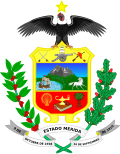Gallery
- Coat of arms of Anzoátegui, adopted in 1933
- Coat of arms of Barinas, adopted in 1910
- Coat of arms of Bolívar, adopted in 1922
- Coat of arms of Cojedes, since 1960
- Coat of arms of Falcón, adopted in 1950
- Coat of arms of Guárico, since 1912
- Coat of arms of Lara, adopted in 1905
- Coat of arms of Mérida, since 1905
- Coat of arms of Nueva Esparta, adopted in 1917
- Coat of arms of Portuguesa, since 1948
- Coat of arms of Sucre, since 1910
- Coat of arms of Trujillo, since 1905
- Coat of arms of Zulia, since 1917





















